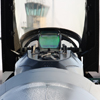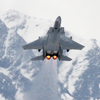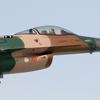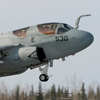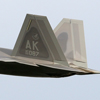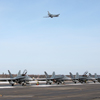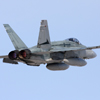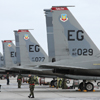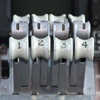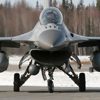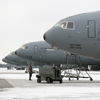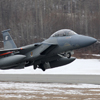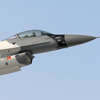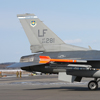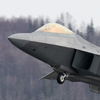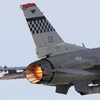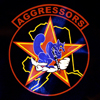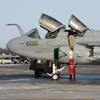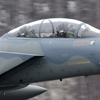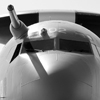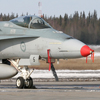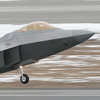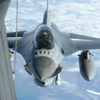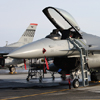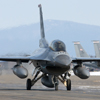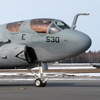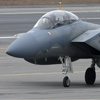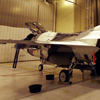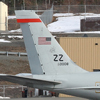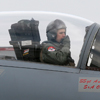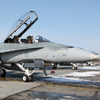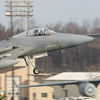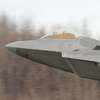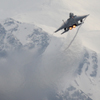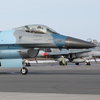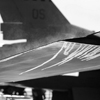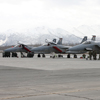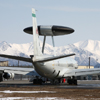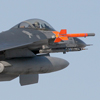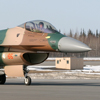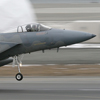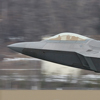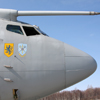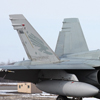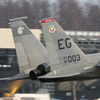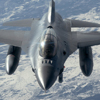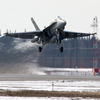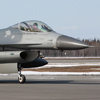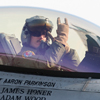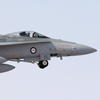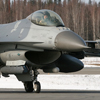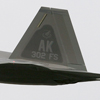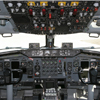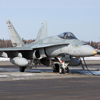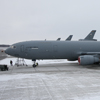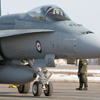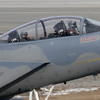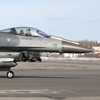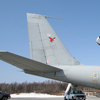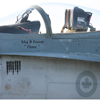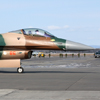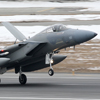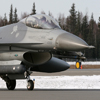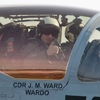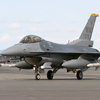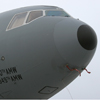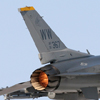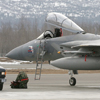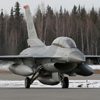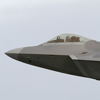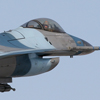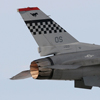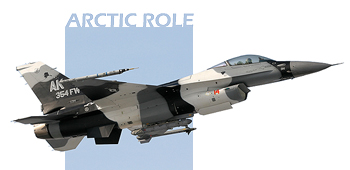
Red Flag Alaska 2008 Feature Report
Thursday 3rd April - Friday 18th April
Red Flag Alaska is a Pacific Air Forces (PACAF) sponsored exercise. After the eruption of Mount Pinatubo in the Philippines in 1991, Exercise Cope Thunder, held at Clark AFB in the aforementioned country was forced to relocate to Eielson AFB, near Fairbanks, Alaska the following year. In 2006, Cope Thunder was given the new title, "Red Flag Alaska". Today the hosting of the exercise is shared with Elmendorf AFB, some 300 miles south west of Eielson, located on the outskirts of the city of Anchorage.
reports for UK Airshow Review. All photography by the author.
Cope Thunder was essentially the PACAF equivalent of the original Red Flag exercise, first staged in Nellis, Nevada in 1975. Borne out of a desperate need to reduce combat attrition rates that had seen the US Air Force dominance in the skies plummet from 20:1 kill ratios during WW2, down to 10:1 during the Korean conflict, before nose-diving yet further to below 2:1 during certain periods of Vietnam.
It was believed that this loss of aerial dominance was at least partly explained by the fact that no air-to-air combat training was given to new pilots, and no realistic threats were provided, ironically, in case it led to a peacetime crash.
The Pentagon ordered a study into all of the air-to-air engagements during Vietnam, piecing together all of the information available and wherever possible reconstructing with ribbon diagrams the way these engagements panned out. This was known as the Red Baron Study and provided key information that would provide the USAF with a clear indication as to what was required in order to reassert their former air superiority. Most significantly Red Baron highlighted that if a pilot were to survive ten combat missions, his chances of surviving the whole tour of duty would rise exponentially.
Logic therefore dictated a requirement to provide the most sophisticated, realistic training environment possible, so as to enable those going to war to fly those first ten combat missions safe in the knowledge that no-one would actually be shooting them out of the sky. The whole essence of the Red Flag exercise is that it allows you to make mistakes, but because no-one is really attacking you, you literally learn to survive through experience.
In order to achieve this requirement, amongst other things a new Squadron of 'Aggressor' aircraft was formed. The intention was that these aircraft would fly and fight in the same way as Russian fighter aircraft of the same era would, thus making the training more realistic and worthwhile for those undertaking it.
The threat simulation provided did not end there. The bad guys, the "Red Forces", would also have access to ground assets such as SAM sites and the like.
The introduction of video playbacks, both in cockpit and from positions alongside ground targets, enabled a crystal clear picture of the 'outcome' of each element of the 'fight', and more crucially to highlight who would and who wouldn't live to fight another day.
Today, coalition partners regularly attend and actively participate in the exercises. It's vitally important that all coalition forces learn to train like you fight, because it then makes it so much easier to fight like you train as a package, if you ever do get called into a real world battle. Gulf War 1 highlighted this need perfectly as no-one else fought in the way the US did.
Red Flag Alaska differs from the more traditional Red Flag exercises hosted at Nellis AFB, Nevada, in that the assets are spread between the two host bases, amongst other things.
Hosted by the 353rd Combat Training Squadron, on average more than 700 people and up to 60 aircraft are deployed to Eielson AFB, with another 500 people and 40 aircraft taking up temporary accommodation at Elmendorf AFB, for each Red Flag Alaska period. This division is both necessary (due to available ramp space) and realistic, since very few wartime locations are big enough to allow all assets to operate from the same airfield. It is therefore good practice for remote planning, debriefing and the like, using traditional methods like the telephone.
Unlike Nevada, Alaska and the western Canadian airspace that's used during RF-A provides a tremendous variety of differing terrains. Everything from flat tundra, through to rolling hills and steep mountains can be found, each offering its own intricacies and challenges applicable to real world operations. More than 67,000 square miles of airspace is used in total and comprises 17 military operations and high altitude training areas, plus two restricted zones.
Red Flag Alaska 08-2 was the first exercise in the series to witness participation by the 'new' Block 30 Aggressor colour schemed F-16C/Ds of the 18th Aggressor Squadron, 354th FW, resident at Eielson AFB. Previously, the then 18th Fighter Squadron had flown Block 40 models, but a straight swap was done with the earlier examples from Kunsan AFB, South Korea. Since these aircraft will be used exclusively in this role there's no requirement for them to be the latest models with all mod-cons; the Block 30 airframe is more than adequate for the job. As you would expect, these guys are solely used as "Red Air" assets.
Three colour schemes are carried, with one being completely exclusive to the unit – the black/grey/white arctic style camo, not only ideal for much of Alaska's terrain, but also bearing an uncanny resemblance to that sported by the Sukhoi Su-27SKM Flanker of the Russian Air Force.
Other resident Alaskan participation came from Elmendorf AFB's 3rd Wg. The 90th FS provided eight F-22A Raptors in both the air-to-air and air-to-ground roles, while the 962nd AACS made a single E-3B/C airframe available in the Airborne Warning And Control System (AWACS) role. That role was shared with both the 961st AACS, 18th Wg, Kadena AFB, Japan and also the Royal Air Force's own 8 and 23 Sqns from RAF Waddington - the latter each providing one crew and sharing a jet.
"Rage", currently an F-22 pilot with the 90th FS, but with experience of a Red Flag exercise from the controls of the F-15C explained how the involvement of the two types differ.
"The air-to-air mentality is basically the same, but the Raptor also brings with it more of a battlefield-management role. We have the responsibility for assimilating information, making decisions based on it, and then disseminating it to the other aircraft.
"Because nothing else currently has the secure data links that exist from Raptor to Raptor, we're tasked with verbally passing this information on, and that can be quite a different challenge.
"As an Eagle flight leader my responsibility would stop with the four aircraft in my formation. As a Raptor pilot that responsibility stretches much wider.
"We take the view that one Raptor is roughly equivalent to two Eagles in the roles it undertakes."
In addition to the E-3, Kadena also provided three HH-60G Pave Hawks of the 33rd RQS, 18th Wg. Their traditional role is to provide Combat Search And Rescue (CSAR) facilities to downed aircrews. These were stationed at Eielson.
The Canadian Armed Forces sent eight CF-188 Hornets to 'play' from 409 TFS, based at CFB Cold Lake, Alberta. These were not the only Hornets present, however. Crews from No 75 Sqn, Royal Australian Air Force were also there with a similar number of their own aircraft, from RAAF Tindal, in the Northern Territory, and carrying a mix of squadron markings. Both sets of aircraft were also resident at Eielson for the duration.
The Hornets were massively outnumbered by F-16s there. In addition to the Aggressors, the 14th FS, 35th FW from Misawa AFB, Japan, the 36th FS, 51st FW from Osan AFB, South Korea, and both the 61st and 62nd FS, 56th FW from Luke AFB, Arizona were also present. Each unit had somewhere in the region of ten jets available to them.
Two sets of visiting "Blue Air" fighter assets were stationed at Elmendorf. 16 F-15C/D Eagles from the 60th FS, 33rd FW from Eglin AFB, Florida, as well as six F-22A Raptors from the 43rd FS, 325th FW based at Tyndall AFB, also in Florida, operated from there.
"Nogs", an F-15C jockey explained how important Red Flag exercises in general are for those heading off into battle. "In Florida we train over the Gulf of Mexico and we fly solely against other F-15s. It's part-task training only. Here we get to fly as part of an integrated package, which provides a realistic flavour of real-world contingencies.
Eglin's detachment commander, Lt Col David "Gorby" Baggio described how hard his ground crews had worked to get their aircraft fit and to keep them that way after their recent grounding due to a longeron flaw, which had led to the mid-air breakup of a Missouri ANG example back in November. "We brought 16 aircraft with us and we could fly all sixteen this morning. That's awesome. It's not just the aircrews that benefit from Red Flag. The groundcrews do too. Having to keep your jet serviceable away from home is no mean feat".
Providing Electronic Warfare support for the "Blue Forces" was a triumvirate of EA-6B Prowler aircraft; two were drawn from VAQ-133 "Wizards", at NAS Whidbey Island, WA, whilst the third came from the seldom seen VAQ-209 "Star Warriors", from Andrews, MD.
Tanker support on this occasion was provided to both sides by five KC-10A Extenders that were deployed to Eielson, though only a couple were used (at most) to support each mission. They and their crews were drawn from the two remaining units that operate the type, namely the 60th AMW (who sent crews from both the 6th and the 9th ARS) from Travis AFB, California, and the 305th AMW (whose crews were drawn from the 2nd ARS, and whom I was fortunate enough to fly with) from McGuire AFB, New Jersey.
With Elmendorf around a 45 minute transit time from Eielson, the KC-10s were the first assets to take to the skies from the latter location, topping up the gas on the Elmendorf traffic before the fight got underway proper. During the media day at Eielson the KC-10 involved launched a full two hours before the next departure from there, that being the Aggressor F-16s, who used the apt callsign, "MiG".
As per the Red Flag ethos, everything is done in the chronological order that it would be during a real wartime scenario – train like you fight, fight like you train. That means that you look to take out enemy radar sites that would have otherwise given warning of your impending attack first, before going ahead with any large scale bombing campaigns.
A number of the Misawa based F-16s were engaged in this role (the Suppression of Enemy Air Defences – SEAD), armed with the AGM-88 Harm Air-to-Surface missile.
Several of the Luke examples appeared to be more concerned with the air-to-air role, sporting an inert dayglo-orange AIM-9 Sidewinder on the starboard wingtip rail.
The majority of the remaining Blue Force's F-16s and Hornets carried the LITENING designator pod, aside from a handful that sported the SNIPER pod. Though it wasn't confirmed, it's likely that these were 'illuminating' ground targets for the air-to-ground munitions carried by the F-22 Raptors operating from Elmendorf.
There can be no underestimating just how important Red Flag Alaska is to those taking part. Moving forward, the vision is that the 'regular' Red Flag and the Alaskan versions will remain sufficiently different, yet complimentary, and that participants at Nellis one year will rotate through the Alaskan equivalent the following year.

